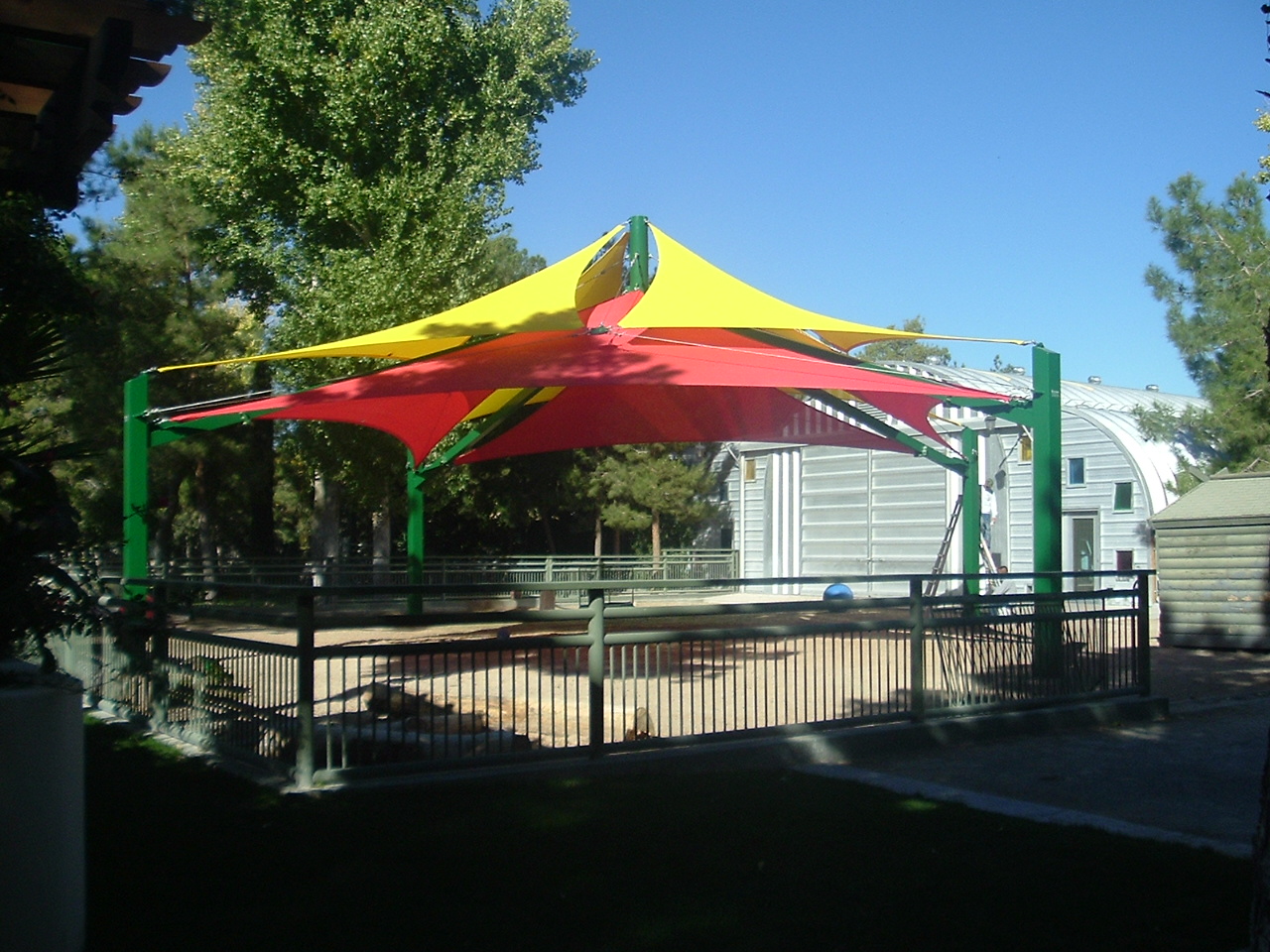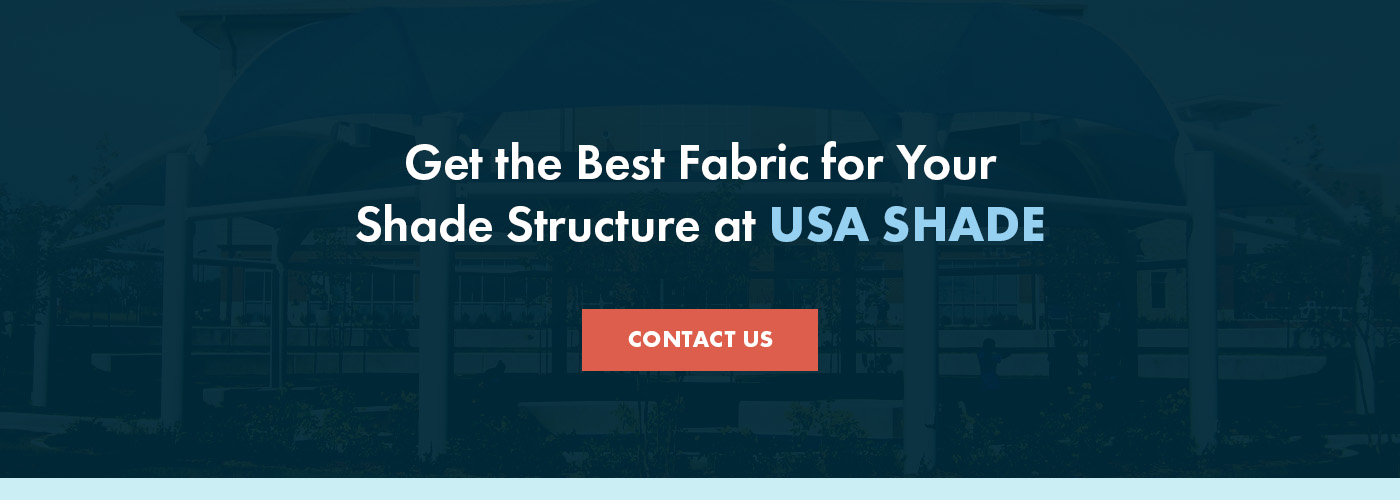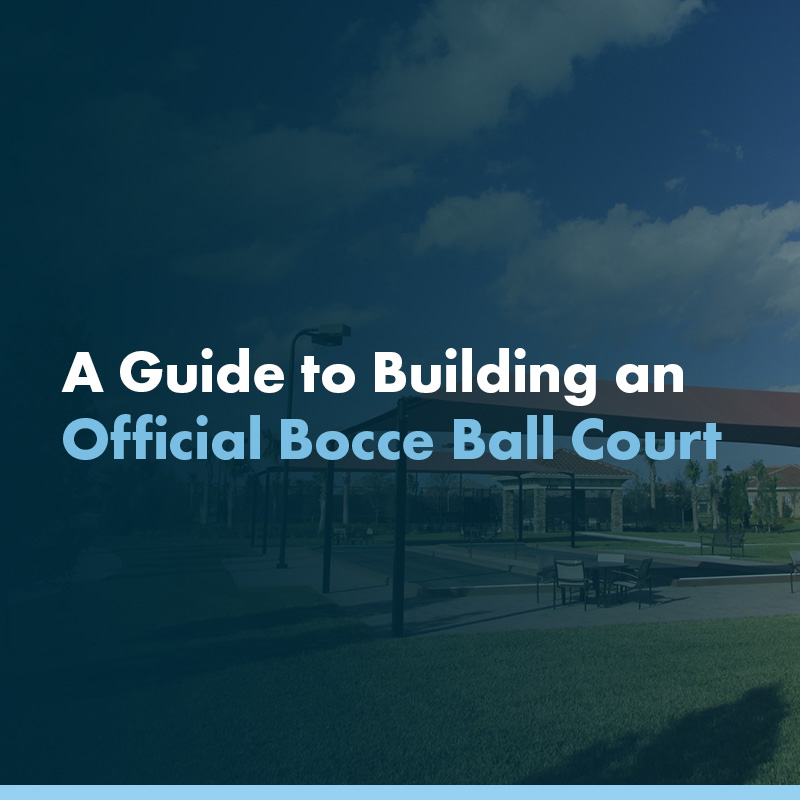
If you own or manage a school playground, park, outdoor gym or recreational area, understanding the value of fabric shade structures is important for providing your guests with a safe and memorable experience. Ever-changing weather and serious sun exposure can be uncomfortable and unsafe for visitors and damage property such as vehicles and recreation equipment.
That said, how do you know which type of fabric meets the needs of your shade structure? Many types of fabrics exist, and factors like color, durability and weather resistance can all impact your shade structure in different ways. By selecting the right fabric option, you can create a shade structure system that protects people and property and looks great.
This guide will help you navigate your options and show you how to choose the best shade fabric for your business or project.
Top Fabrics for Shade Structures
Whether you need to assess fabric for parking shade structures or public spaces, the type you choose is crucial, as it impacts longevity, performance and aesthetics. Here are some of the top fabrics for shade structures:
High-Density Polyethylene (HDPE)
HDPE is a thermoplastic polymer and one of the two main polythene types, with many applications in modern manufacturing. It’s also spun into fabric for sunshades and features a high-density mesh with exceptional UV-A and UV-B ray protection. As a mesh fabric, HDPE is breathable, allowing air to pass through, making it ideal for areas where ventilation is crucial, such as kid’s playgrounds. While HDPE is not waterproof, it offers excellent performance.
PVC Coated Polyester
As one of the most durable fabric structures, polyvinyl chloride (PVC) is a top choice for protecting against the elements. Polyester is durable and provides effective water resistance when combined with PVC coating, making it one of the best waterproof materials for shade structures. The combination significantly contributes to the fabric’s strength and abrasion resistance, making it suitable for harsh conditions.
In addition to water resistance, PVC-coated polyester is flame-retardant, easy to clean, wrinkle-proof and wind-proof. While less breathable than other fabrics, it still effectively blocks out the elements. Since PVC is a heavier material, it requires a strong support structure to ensure long-term use.
Acrylic Fabric
Acrylic fabric is a high-quality textile material made from tiny synthetic fibers that make it highly resistant to ultraviolet (UV) rays, sun damage and chemicals. In its basic form, acrylic is naturally sturdy and durable while being soft and flexible. Due to its many applications, this material is generally modified to different versions of acrylic such as modacrylic, lastrile and nytril. Depending on the type of acrylic used, the fabric can be flame-resistant, abrasion-resistant or fade-resistant.
Polytetrafluoroethylene (PTFE)
PTFE is known for its incredible performance and durability. Compared to other materials, its superior strength makes it a great choice for protecting from the sun, wind and rain.
As one of the best fabrics for shade structures, PTFE offers a lasting solution for long-term, uninterrupted functionality and great appearance. Due to the fabric’s long service life and rigidity, it’s the best material for permanent structures and ideal for high-end commercial settings and community spaces.
How Do You Choose the Right Shade Fabric?
Choosing the right fabric is a crucial step in your shade structure project. You want to select a fabric that meets the needs of the project in terms of performance, durability and overall aesthetics.
While each fabric has its unique qualities, taking into account project goals and vision will help you find a product that offers the best possible outcome. Here are key factors to consider when choosing the right fabric:
UV Protection

One of the main reasons for erecting shade structures in outdoor spaces is to protect visitors from the sun’s harmful rays. Investing in a high-quality shade can help block UV exposure by as much as 75%. When considering fabric shade structures for your project, two excellent measures of quality to observe are shade factor and UV blockage, as they tell you how much shade and UV protection the fabric offers.
Shade factor refers to how much shade the fabric defects or absorbs. Since shade factor is expressed in percentage, you can expect fabrics with as low as 46% shade factor and as high as 96% shade factor. Keep in mind that a material’s shade factor is mainly about the amount of light that penetrates, which doesn’t necessarily correlate with the level of UV protection. Some fabrics have lower shade factors, allowing more light but still demonstrating high UV protection rates.
For areas that need more light, you could opt for fabrics with low shade factors that still maintain high UV blockage rates. However, outdoor areas with intense sunlight may require the highest shade factors and UV blockage rates you can find. Remember, different factors such as material composition, weave openness and color can impact the level of shade factor and UV blockage.
Explore USA SHADE’s quick ship shade structures to see how different fabric characteristics affect both UV blocking capability and shade factor.
Durability
It’s important to consider material durability when selecting the type of fabric for your shade structure. Since durability indicates how resistant a piece of fabric is to wear and tear, you may want to choose the most durable material to ensure longevity. However, other factors, such as flexibility, breathability and UV protection, also require consideration.
Some of the things to keep in mind that impact fabric durability include:
- Weight: Fabric weight influences many properties of the fabric, such as thickness, rigidity and air permeability. If you’re looking for flexibility, a heavy fabric may not be your best option, but it would be if you’re considering longevity.
- Thickness: Fabric thickness impacts resilience, thermal insulation, stiffness and propensity for abrasion. You may want to ask your shade structure manufacturer about the thickness of the fabric and what it means in terms of the durability of your shade structure.
- Strength: Fabric strength can mean the fabric’s capacity to stretch, resistance to tearing and resistance to bursting. You may want to confirm how the fabric holds under certain conditions.
Sustainability
With sustainability becoming more of a concern, it makes sense to consider sustainability when selecting fabric shade structures. By picking a more eco-friendly material that still guarantees quality, you reduce your carbon footprint and promote sustainable practices.
The resources used in the production process and the material life cycle are two main factors in determining fabric sustainability. The more resources a fabric consumes, the less sustainable it is. Acrylic and HDPE, for example, are highly recyclable, which gives them a long life cycle. While resistant to degradation, recycling HDPE and acrylic presents a responsible solution to the question of environmental pollution.
Another environmentally friendly fabric option is PTFE. PTFE-coated fiberglass offers a long life span with low maintenance needs, reducing resource consumption. While PTFE is not the most sustainable compared to HDPE and acrylic, it has a promising recycling future.
Weather Resistance
Resistance to weather conditions is a key factor when buying shade fabric. There are permeable and waterproof solutions, each with its advantages and disadvantages. Permeable fabrics have more space between the threads, which makes them breathable and ideal for scenarios that require proper ventilation. However, while permeable fabrics allow free air circulation, they also allow rainwater or melted snow to seep through the loosely woven fibers.
If you’re particularly interested in fabrics that don’t leak when it rains, you’ll need to select non-permeable or waterproof fabrics, such as PVC and PTFE. Due to their tightly woven construction, they block water and air from penetrating, keeping the shaded area dry and debris-free. While non-permeable shade fabrics lack breathability, they provide excellent performance during extreme weather conditions.
When selecting fabrics based on weather resistance, it’s important to remember the unique benefits each type offers and how that translates into your project.
Cost Effectiveness
Various factors contribute to the price of shade fabrics, such as material, weave construction, and other properties that determine quality and durability. While the initial costs of quality fabric may be high, features like performance, low maintenance and durability can make the investment cost-efficient in the long run. Balancing quality and budget is a great way to ensure you get the best product while working within your means.
Color

Color is a key factor when selecting fabrics for shade structures because your choice of color influences the structure’s appearance. However, there’s more to choosing a color for shade fabrics, as it also plays a significant role in fabric performance. Colors contribute to the fabric’s shade factor and UV blockage capacity. They also contribute to fade resistance, which impacts the project’s aesthetics.
Powder Coating
Powder coating is a premium solution for fabric shade structures with many additional advantages. Compared to traditional paint finishes, powder coating is incredibly durable, with better UV resistance, fade resistance, and resistance to scratches, chips and abrasions.
When selecting fabric finishing, consider powder coating to benefit from maximum adhesion and resistance from most wear and tear associated with common liquid paints. Since the technology offers a broad range of color options, you can expect to find a color that best fits the needs of your project.
Warranty
While product features give you the best picture regarding quality and longevity, a warranty assures you those features are what the manufacturer says they are. Reputable manufacturers will have no problem standing behind their products. For example, USA SHADE offers a 10-year limited manufacturer’s warranty for its shade selection. When purchasing shade structures, it’s wise to ask about product warranty as it secures your investment.
Benefits of Choosing Quality Fabric for Shade Structures
Quality is a huge factor when shopping for fabric shade structures, as it has far-reaching consequences for your business or architectural project. Here are the benefits of selecting quality fabric for shade structures:

- Project success: Investing in high-grade fabric is key to project success. Whether it’s a business venture or a sponsored community shade project, getting it right with the material is crucial.
- Aesthetic appeal: While function is important, appearance contributes to the overall appeal of shade structures. Quality fabrics infuse style into the structure, creating an inviting and sophisticated outdoor space.
- Guaranteed longevity: Top-quality materials offer premium features that are absent from standard materials. By investing in quality shade fabrics, you get features that guarantee longevity, such as strong construction and resistance to wear and tear.
- Low maintenance: One of the main selling points of commercial-grade fabrics is their resilience. Unlike standard alternatives, high-grade fabrics withstand rough conditions and need far less care and maintenance. With an occasional wash to remove debris, quality fabrics can maintain their original appeal and performance for a long time.
- Versatility: Investing in quality fabrics doesn’t minimize your options. These fabrics offer a range of colors, weave patterns, material compositions and more. As a contractor or business manager, you may want more options when selecting fabric to ensure you find one that meets your design needs while offering style and functionality.
- UV blocking: While UV ray protection is one of the main functions of fabric shade structures, you can trust high-quality fabrics to provide enhanced blocking capacity and maintain a high block rate. Many of these fabrics offer as high as 96% UV protection rates and can maintain these levels long-term.
Get the Best Fabric for Your Shade Structure at USA SHADE
There’s more to choosing fabrics for shade structures than picking one that meets your budgetary needs and looks great. Other factors to pay attention to are material composition, durability, weather resistance and UV protection. If you’re unsure about navigating these features, our expert team at USA SHADE can guide you through your options until you find the right fabric for you.
We’re a full-service shade structure manufacturer with more than three decades of experience in the industry. We understand what goes into developing superior-quality shade structures that meet varying project needs, whether you need shade structures for an outdoor recreation area or a children’s playground. Our products adhere to the best industry standards, from concept to reality.
Browse our quick ship structures or work with our expert team to develop custom designs that meet your vision. Contact us today to get started!






